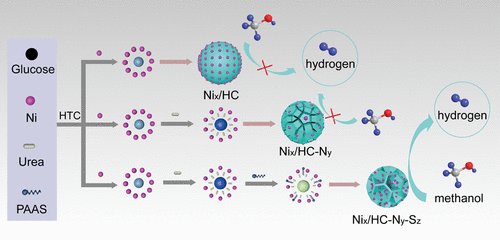当前位置:
X-MOL 学术
›
ACS Appl. Nano Mater.
›
论文详情
Our official English website, www.x-mol.net, welcomes your
feedback! (Note: you will need to create a separate account there.)
Ni/Hydrochar Nanostructures Derived from Biomass as Catalysts for H2 Production through Aqueous-Phase Reforming of Methanol
ACS Applied Nano Materials ( IF 5.3 ) Pub Date : 2021-09-03 , DOI: 10.1021/acsanm.1c01537 Chao Gai 1, 2 , Xia Wang 3 , Jinghai Liu 3 , Zhengang Liu 1, 2 , Yong Sik Ok 4 , Wen Liu 5 , Alex C. K. Yip 6
ACS Applied Nano Materials ( IF 5.3 ) Pub Date : 2021-09-03 , DOI: 10.1021/acsanm.1c01537 Chao Gai 1, 2 , Xia Wang 3 , Jinghai Liu 3 , Zhengang Liu 1, 2 , Yong Sik Ok 4 , Wen Liu 5 , Alex C. K. Yip 6
Affiliation

|
Aqueous-phase reforming of organic molecules to hydrogen is a promising strategy to address the production and storage of sustainable hydrogen with lower costs; however, the synthesis of inexpensive transition metal (TM) catalysts with desirable activity and stability for the reaction is still challenging. In this work, a green and efficient approach for modulating the geometric/electronic structure of metal/hydrochar nanocomposites from sustainable biomass was proposed for enhancing H2 production via aqueous-phase reforming of methanol (APRM). A Ni/HC nanocomposite with a special thistle (a perennial species of flowering plant)-like three-dimensional (3D) architecture was first constructed as a model catalyst to expatiate the critical role of modulating an ordered mesoporous structure and interface electron transfer for enhancing APRM. Deliberately balancing heteroatom doping and soft templates contribute to the successful fabrication of the thistle-like superstructure, and such hierarchically porous architectures demonstrated efficient catalysis for APRM, owing to their unique properties, including a highly uniform morphology, narrow particle size distribution, and mesoporous texture with excellent accessibility. In addition, the experimental investigation and density functional theory calculations both substantiated that the combination of heteroatom doping and soft templates was beneficial for the strong electronic metal–support interaction (EMSI) of the metal/hydrochar nanocomposite, which leads to enhanced methanol adsorption, activation, and subsequently improved APRM performance. The electronic structure of the metal/hydrochar nanocomposite played a more significant effect on the intrinsic APRM activity than the geometric structure like the formation of the thistle-like superstructure. Benefiting from the tailored electronic and geometric structure, the resulting Ni0.1/HC-N1.5-S1 catalyst exhibited an unprecedented average turnover frequency (TOF) of 89.5 molH2/molNi/min, higher than any other known platinum group metal-free catalysts, approaching the reactivity of the state-of-the-art noble metal-based APRM catalysts, while showing excellent stability over 10 consecutive reaction cycles.
中文翻译:

源自生物质的 Ni/Hydrochar 纳米结构作为甲醇水相重整制氢的催化剂
将有机分子水相重整为氢是解决以较低成本生产和储存可持续氢的有前景的策略;然而,合成具有所需活性和稳定性的廉价过渡金属(TM)催化剂仍然具有挑战性。在这项工作中,提出了一种绿色有效的方法来调节来自可持续生物质的金属/水碳纳米复合材料的几何/电子结构,以增强 H 2通过甲醇水相重整 (APRM) 生产。首先构建了一种具有特殊蓟(一种多年生开花植物)样三维(3D)结构的 Ni/HC 纳米复合材料作为模型催化剂,以阐明调节有序介孔结构和界面电子转移的关键作用,以增强年审。有意平衡杂原子掺杂和软模板有助于成功制造类似蓟的上层结构,这种分层多孔结构由于其独特的性质,包括高度均匀的形态、窄的粒度分布和介孔纹理,证明了对 APRM 的有效催化具有出色的可访问性。此外,实验研究和密度泛函理论计算都证实了杂原子掺杂和软模板的组合有利于金属/氢化碳纳米复合材料的强电子金属-载体相互作用(EMSI),这导致甲醇吸附、活化和随后的增强改进的 APRM 性能。与形成蓟状超结构等几何结构相比,金属/水碳纳米复合材料的电子结构对内在 APRM 活性的影响更显着。受益于定制的电子和几何结构,由此产生的 Ni 这导致增强的甲醇吸附、活化和随后改进的 APRM 性能。与形成蓟状超结构等几何结构相比,金属/水碳纳米复合材料的电子结构对内在 APRM 活性的影响更显着。受益于定制的电子和几何结构,由此产生的 Ni 这导致增强的甲醇吸附、活化和随后改进的 APRM 性能。与形成蓟状超结构等几何结构相比,金属/水碳纳米复合材料的电子结构对内在 APRM 活性的影响更显着。受益于定制的电子和几何结构,由此产生的 Ni0.1 /HC-N 1.5 -S 1催化剂表现出前所未有的平均周转频率 (TOF) 为 89.5 mol H2 /mol Ni /min,高于任何其他已知的不含铂族金属的催化剂,接近状态的反应性-最先进的贵金属基 APRM 催化剂,同时在 10 个连续反应循环中表现出优异的稳定性。
更新日期:2021-09-24
中文翻译:

源自生物质的 Ni/Hydrochar 纳米结构作为甲醇水相重整制氢的催化剂
将有机分子水相重整为氢是解决以较低成本生产和储存可持续氢的有前景的策略;然而,合成具有所需活性和稳定性的廉价过渡金属(TM)催化剂仍然具有挑战性。在这项工作中,提出了一种绿色有效的方法来调节来自可持续生物质的金属/水碳纳米复合材料的几何/电子结构,以增强 H 2通过甲醇水相重整 (APRM) 生产。首先构建了一种具有特殊蓟(一种多年生开花植物)样三维(3D)结构的 Ni/HC 纳米复合材料作为模型催化剂,以阐明调节有序介孔结构和界面电子转移的关键作用,以增强年审。有意平衡杂原子掺杂和软模板有助于成功制造类似蓟的上层结构,这种分层多孔结构由于其独特的性质,包括高度均匀的形态、窄的粒度分布和介孔纹理,证明了对 APRM 的有效催化具有出色的可访问性。此外,实验研究和密度泛函理论计算都证实了杂原子掺杂和软模板的组合有利于金属/氢化碳纳米复合材料的强电子金属-载体相互作用(EMSI),这导致甲醇吸附、活化和随后的增强改进的 APRM 性能。与形成蓟状超结构等几何结构相比,金属/水碳纳米复合材料的电子结构对内在 APRM 活性的影响更显着。受益于定制的电子和几何结构,由此产生的 Ni 这导致增强的甲醇吸附、活化和随后改进的 APRM 性能。与形成蓟状超结构等几何结构相比,金属/水碳纳米复合材料的电子结构对内在 APRM 活性的影响更显着。受益于定制的电子和几何结构,由此产生的 Ni 这导致增强的甲醇吸附、活化和随后改进的 APRM 性能。与形成蓟状超结构等几何结构相比,金属/水碳纳米复合材料的电子结构对内在 APRM 活性的影响更显着。受益于定制的电子和几何结构,由此产生的 Ni0.1 /HC-N 1.5 -S 1催化剂表现出前所未有的平均周转频率 (TOF) 为 89.5 mol H2 /mol Ni /min,高于任何其他已知的不含铂族金属的催化剂,接近状态的反应性-最先进的贵金属基 APRM 催化剂,同时在 10 个连续反应循环中表现出优异的稳定性。









































 京公网安备 11010802027423号
京公网安备 11010802027423号